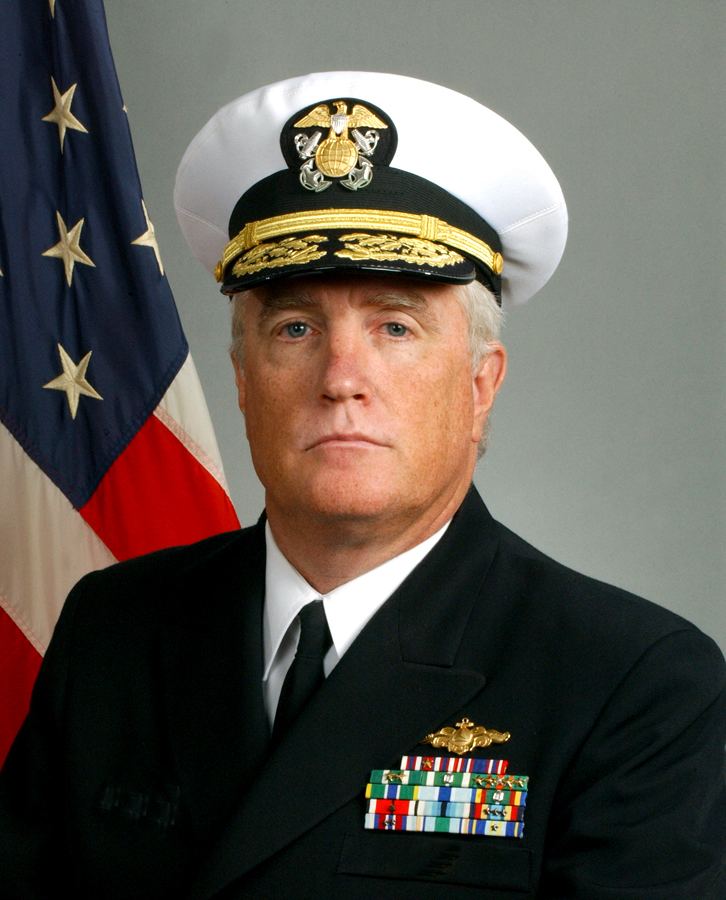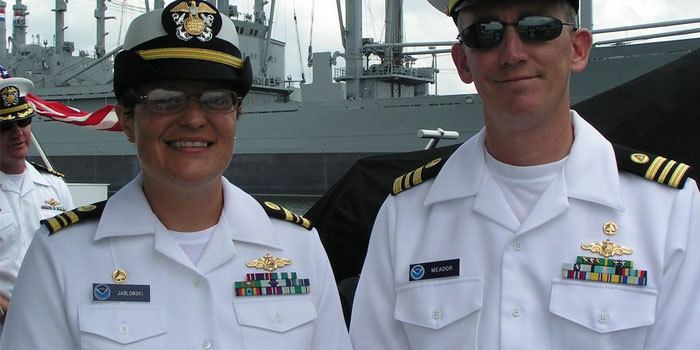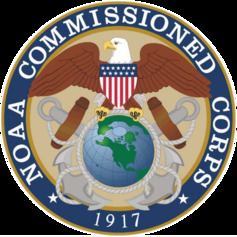Active 22 May 1917 – present | Type Uniformed service Color Blue, White | |
 | ||
Country United States of America Allegiance Constitution of the United States Motto "Science, service, stewardship." | ||
The noaa corps service science adventure
The National Oceanic and Atmospheric Administration Commissioned Officer Corps, known informally as the NOAA Corps, is one of seven federal uniformed services of the United States, and operates under the National Oceanic and Atmospheric Administration (NOAA), a scientific agency within the Department of Commerce. The NOAA Corps is the smallest of the U.S. uniformed services, and one of only two––the other being the United States Public Health Service Commissioned Corps––that consists only of commissioned officers, with no enlisted or warrant officer ranks.
Contents
- The noaa corps service science adventure
- Noaa commissioned officer corps
- Mission
- Early history
- Coast and Geodetic Survey Corps
- ESSA Corps
- NOAA Corps
- Commissioned officers
- Uniforms
- References

Established in 1970, the NOAA Corps is the successor to the United States Coast and Geodetic Survey Corps (1917–1965), and the United States Environmental Science Services Administration Commissioned Officer Corps (ESSA Corps) (1965–1970).

Noaa commissioned officer corps
Mission

The NOAA Corps is the smallest of the seven uniformed services of the United States Government. It has over 300 commissioned officers, but no enlisted or warrant officer ranks. The NOAA Corps today provides a cadre of professionals trained in engineering, earth sciences, oceanography, meteorology, fisheries science, and other related disciplines. NOAA Corps officers operate NOAA ships, fly NOAA aircraft, manage research projects, conduct diving operations, and serve in staff positions throughout NOAA, as well as in positions in the United States Department of Defense, the United States Coast Guard, the National Aeronautics and Space Administration, and the United States Department of State. Like its predecessors, the Coast and Geodetic Survey Corps and the ESSA Corps, the NOAA Corps provides a ready source of technically skilled officers which can be incorporated into the U.S. armed forces in time of war, and in peacetime supports defense requirements in addition to its purely civilian scientific projects. While civilian personnel could perform many of its functions, the advantage of the NOAA Corps as a commissioned service is the quick response time of its personnel, which NOAA can shift among projects and to various places around the world as the need arises more quickly and more easily than it could by reassigning or hiring civilian personnel to meet new or changing requirements.
Early history

The NOAA Commissioned Officer Corps traces its roots to the United States Coast and Geodetic Survey. The Coast and Geodetic Survey's predecessor, the United States Survey of the Coast – renamed the United States Coast Survey in 1836 – was founded in 1807 under President Thomas Jefferson. Until the American Civil War, the Coast Survey was manned by civilian personnel working with United States Army and United States Navy officers. During the Civil War (1861–1865), Army officers were withdrawn from Coast Survey duty, never to return, while all but two Navy officers also were withdrawn from Coast Survey service for the duration of the war. Since most men of the Survey had Union sympathies, most stayed on with the Survey rather than resigning to serve the Confederate States of America; their work shifted in emphasis to support of the U.S. Navy and Union Army, and these Coast Surveyors are the professional ancestors of today's NOAA Corps. Those Coast Surveyors supporting the Union Army were given assimilated military rank while attached to a specific command, but those supporting the U.S. Navy operated as civilians and ran the risk of being executed as spies if captured by the Confederates while working in support of Union forces. After the war, U.S. Navy officers returned to duty with the Coast Survey, which was given authority over geodetic activities in the interior of the United States in 1871, and was subsequently renamed the United States Coast and Geodetic Survey in 1878.

With the outbreak of the Spanish–American War in April 1898, the Navy again withdrew all of its officers from Coast and Geodetic Survey assignments. They returned after the war ended in August 1898, but the system of U.S. Navy officers and men crewing the Survey's ships that had prevailed for most of the 19th century came to an end when the appropriation law––approved on June 6, 1900––provided for "all necessary employees to man and equip the vessels," instead of Navy personnel. The law took effect on July 1, 1900; at that point, all Navy personnel assigned to the Survey's ships remained aboard until the first call at each ship's home port, where they transferred off, with the Survey reimbursing the Navy for their pay accrued after July 1, 1900. From July 1900, the Coast and Geodetic Survey continued as an entirely civilian-manned organization until after the United States entered World War I in April 1917.
Coast and Geodetic Survey Corps
To avoid the dangers that Coast Survey personnel had faced during the Civil War of being executed as spies if captured by the enemy, the United States Coast and Geodetic Survey Corps was established on 22 May 1917, giving Coast and Geodetic Survey officers a commissioned status so that under the laws of war, they could not be executed as spies if they were captured while serving as surveyors on a battlefield during World War I. The creation of the Coast and Geodetic Survey Corps also ensured that in wartime a set of officers with technical skills in surveying could be assimilated rapidly into the United States armed forces so that their skills could be employed in military and naval work essential to the war effort. Before World War I ended in November 1918, over half of all Coast and Geodetic Survey Corps officers had served in the U.S. Army, U.S. Navy, or United States Marine Corps, performing duty as artillery orienteering officers, as minelaying officers in the North Sea (where they were involved in the laying of the North Sea Mine Barrage), as navigators aboard troop transports, as intelligence officers, and as officers on the staff of American Expeditionary Force commanding officer General John "Black Jack" Pershing.
The Coast and Geodetic Survey Corps returned to peacetime scientific pursuits after the war. Its first flag officer was Rear Admiral Raymond S. Patton, who was promoted from captain to rear admiral in 1936.
When the United States entered World War II in December 1941, the Coast and Geodetic Survey Corps again suspended its peacetime activities to support the war effort, often seeing front-line service. Over half of all Coast and Geodetic Survey officers were transferred to the U.S. Army, U.S. Navy, U.S. Marine Corps, or United States Army Air Forces, seeing duty in North Africa, Europe, the Pacific, and in the defense of North America as artillery surveyors, hydrographers, amphibious engineers, beachmasters (directors of disembarkation), instructors at service schools, and in a wide variety of technical positions. They also served as reconnaissance surveyors for a worldwide aeronautical charting effort, and a Coast and Geodetic Survey officer was the first commanding officer of the Army Air Forces Aeronautical Chart Plant at St. Louis, Missouri. Three officers who remained in Coast and Geodetic Survey service were killed during the war, as were eleven other Survey personnel.
After the war ended in August 1945, the Coast and Geodetic Survey again returned to peacetime scientific duties, although a significant amount of its work in succeeding years was related to support of military and naval requirements during the Cold War.
ESSA Corps
When the Coast and Geodetic Survey was transferred to the newly established Environmental Science Services Administration on July 13, 1965, control of the corps was transferred from the Coast and Geodetic Survey to ESSA itself, and accordingly, the corps was redesignated the United States Environmental Science Services Administration Commissioned Officer Corps, known informally as the ESSA Corps. The ESSA Corps retained the responsibility of providing commissioned officers to operate the Coast and Geodetic Survey's ships and of providing a set of officers with technical skills in surveying for incorporation into the U.S. armed forces during wartime.
Following the establishment of the ESSA, Rear Admiral H. Arnold Karo was promoted to vice admiral in order to help lead the agency. He served as the first Deputy Administrator of ESSA, and was the first vice admiral, and at the time the highest-ranking officer, in the combined history of the Coast and Geodetic Survey Corps and ESSA Corps. Rear Admiral James C. Tison, Jr. was the first director of the ESSA Corps.
NOAA Corps
The ESSA was reorganized and expanded to become the new National Oceanic and Atmospheric Administration on October 3, 1970. As a result, the ESSA Corps was redesignated the National Oceanic and Atmospheric Administration Commissioned Officer Corps, known informally as the NOAA Corps. Rear Admiral Harley D. Nygren was appointed as the first director of the new NOAA Corps.
In 1972, the NOAA Corps became the first uniformed service of the U.S. Government to recruit women on the same basis as men. On June 1, 2012, the NOAA research vessel RV Gloria Michelle, a boat manned by two NOAA Corps personnel, became the first vessel in the history of NOAA (or its ancestor organizations) to have an all-female crew.
On January 2, 2014, Michael S. Devany was promoted to vice admiral upon assuming duties as Deputy Under Secretary for Operations at NOAA, becoming only the second vice admiral in the combined history of the Coast and Geodetic Survey Corps, ESSA Corps, and NOAA Corps, and the first since the promotion of Vice Admiral Karo in 1965.
Commissioned officers
The NOAA Corps uses the same commissioned officer ranks as the U.S. Navy and U.S. Coast Guard. While the grade of admiral has been established as a rank in the NOAA Corps, the rank has not been authorized for use by the United States Congress. Current NOAA Corps ranks rise from ensign to vice admiral, pay grades O-1 through O-9 respectively. NOAA Corps officers are appointed via direct commission and receive the same pay as other members of the uniformed services. They cannot hold a dual commission with another service, but inter-service transfers are sometimes permitted.
NOAA commissioned officers can be militarized by the President.
33 USC 3061 states:
Uniforms
For formal service uniforms, the NOAA Corps wears the same Service Dress Blues and Service Dress Whites as the U.S. Navy, but with NOAA Corps insignia in place of U.S. Navy insignia. For daily work uniforms, the NOAA Corps wears the same Operational Dress Uniform (ODU) as the U.S. Coast Guard, but with NOAA Corps insignia in place of U.S. Coast Guard insignia.
